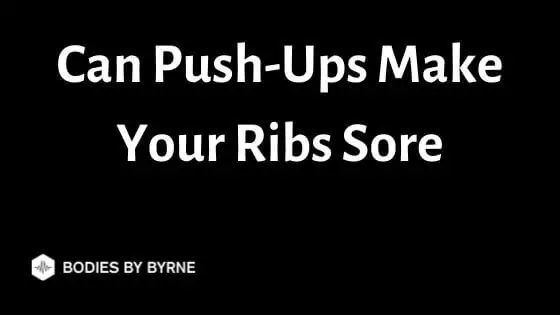If you are reading this, chances are you’ve introduced push-ups into your training routine, expected to have some feeling of soreness and DOMS in your chest, triceps, and front delts the next day but were instead left with soreness around your ribs.
Your first thought is going to be “is this normal” and then you’ll wonder can push-ups make your ribs sore and be the cause?
Push-ups can make the intercostal muscles and serratus anterior muscles sore as these are the muscles surrounding your ribs. Push-ups engage these muscles as stabilizers during the exercise so they are stimulated but bad training form can lead to them being over-used which leads to soreness.
While it seems like a very basic exercise, the push-up is actually a movement that engages countless muscle groups. While that’s generally considered to be a good thing, it can also highlight weak and underdeveloped muscles as a result.
In this article, I’ll cover why push-ups make your ribs sore and what you can do to prevent this moving forwards.
Can Push-Ups Make Your Ribs Sore
Push-ups can make your ribs sore because of the surrounding stabilizing muscles that are active during the movement. While it’s natural that they will be active during a movement, most beginners will either have underdeveloped/weak stabilizing muscles or be using incorrect form.
I’ll provide a video a little later in this article to show how poor/incorrect form can shift the tension away from the major muscle groups (chest, triceps, front delts) and onto the supporting stabilizing muscles. For now, it’s best to note that there is a range of stabilizing muscles that surround the ribs and are active during a push-up.
These include the intercostal muscles which are located in between the ribs, the serratus anterior which is located at the back of the ribs (more on this later), and the pec minor which crosses multiple ribs of the mid-chest.
All of these muscle groups insert or cross the ribs in some form and are acting as stabilizing or working muscle groups during the push-up. Therefore, push-ups won’t make your ribs sore but they are highly likely to make the surrounding muscles of the rib sore after push-ups.
This is more true if these muscle groups are underactive or noticeably weak. While they are active to some degree during a bench press, for example, they do not need to work as hard to stabilize the weight as you will be lying on a flat surface for support and balance.
During a push-up, however, these muscle groups need to work much harder to keep the torso stable and this is why the push-up can easily highlight a weakness in these often underactive muscle groups.
Why Your Sides Hurt After Doing Push-Ups
Push-ups can make your ribs sore because of the surrounding stabilizing muscles that are active during the movement. While it’s natural that they will be active during a movement, most beginners will either have underdeveloped/weak stabilizing muscles or be using incorrect form.
When it comes to your sides hurting, this will most likely be a result of the serratus anterior muscle which runs down your side (at the back of your ribs and attaches close to lats). I recently covered why people get sore lats after push-ups and the reasons are very similar to sore sides and ribs.
Firstly, as covered above the main reason for sore ribs and sides is because the stabilizing and supplementary muscle groups are active during a push-up. This is natural and necessary but poor form can be the main reason why your sides are hurting more than they should.
This video below is the best example I’ve ever seen for push-up form and how some slight adjustments can completely shift the tension from the chest and onto the serratus anterior muscles along your side along with the lats.
As you can see, by moving the scapula through an excessive range of motion, the muscle groups along your side end up being those that are primarily active and will receive the most stimulation from the exercise.
There’s a certain rule of thumb when it comes to exercise execution and that is the muscle that moves first in the movement (the initiating muscle) is usually going to be the one that takes over on an exercise.
Final Thoughts
Push-ups can make your ribs sore as a result of placing a greater emphasis on the smaller stabilizing muscle groups that surround the ribs.
These muscle groups are active at the front, side, and even the rear of your ribs, and depending on your form or strength of these supporting muscles, it’s likely you are going to overwork or overstimulate them.
With frequent use of the push-up, these muscles will strengthen and adapt so it’s not something to be concerned with but when you first introduce push-ups to your routine, it’s highly likely that you are going to experience sore ribs and sides for the first few training sessions at least.
